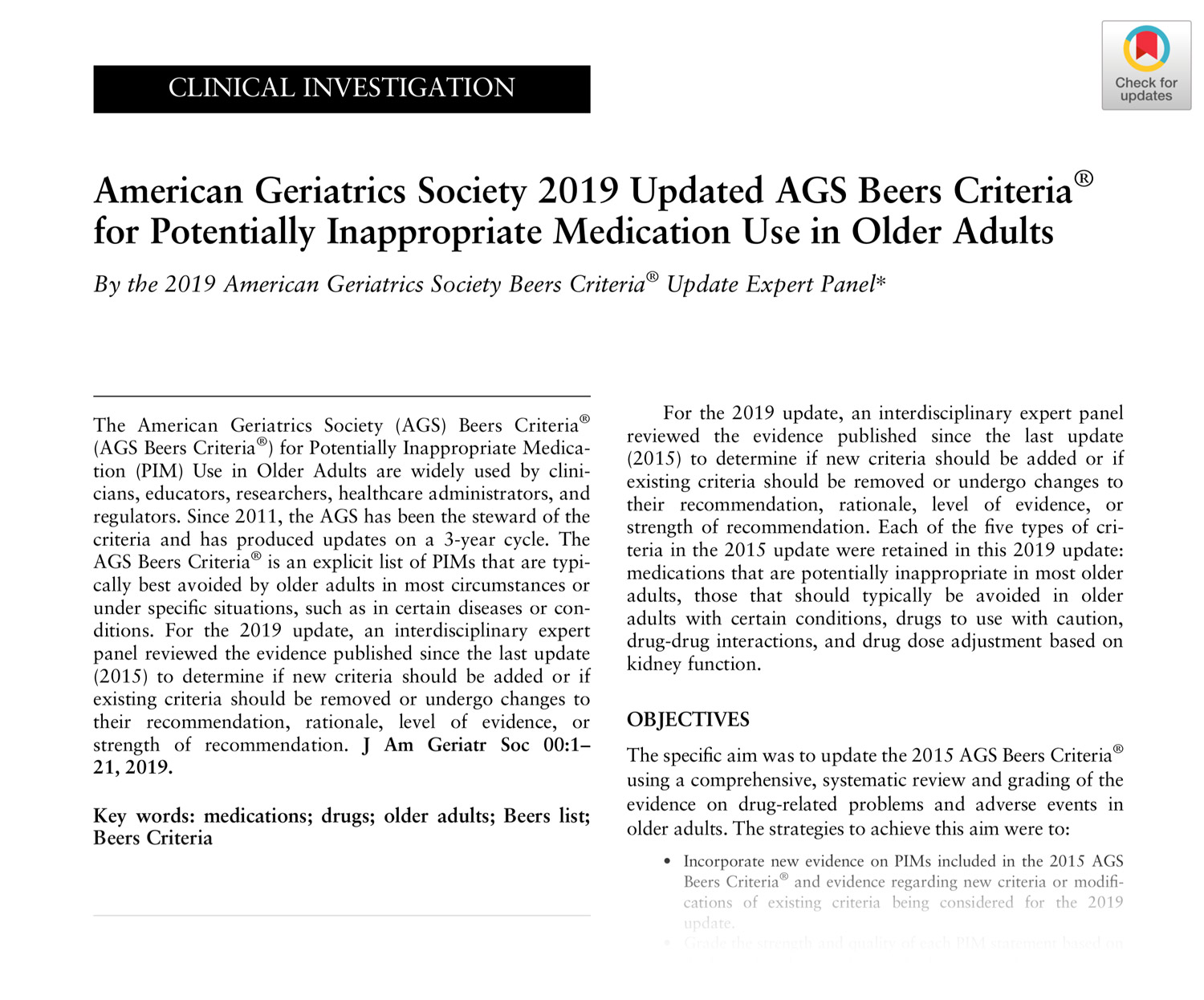 The 2019 AGS Beers Criteria® includes 5 lists of nearly 100 medications or medication classes to avoid or use with caution for some or all older adults.
The 2019 AGS Beers Criteria® includes 5 lists of nearly 100 medications or medication classes to avoid or use with caution for some or all older adults.
The American Geriatrics Society (AGS) recently unveiled its latest update to one of geriatrics’ most frequently cited reference tools: The AGS Beers Criteria® for Potentially Inappropriate Medication Use in Older Adults. With more than 90% of older people using at least 1 prescription and more than 66% using 3 or more in any given month,1 the criteria—a compendium of medications potentially to avoid or consider with caution because they often present an unfavorable balance of benefits and harms for older people—plays a vital role in helping health professionals, older adults, and caregivers work together to ensure medications are appropriate.
“Medications play an important role in health and wellbeing for many older people,” noted Donna M. Fick, PhD, RN, FGSA, FAAN, a co-chair of the expert panel responsible for the 2019 AGS Beers Criteria. “With this new update, we hope the latest information on what makes medications appropriate for older people can play an equally important role in decisions about treatment options that meet the needs of older adults while also keeping them as safe as possible.”
Published in its entirety in the Journal of the American Geriatrics Society,2 the AGS Beers Criteria also includes several resources—from mobile apps to a pocket reference card—to help clinicians implement prescribing recommendations (available at GeriatricsCareOnline.org), as well as tools to aid older adults and caregivers in understanding what “potentially inappropriate” medications mean (available for free at
HealthinAging.org).
What is the AGS Beers Criteria?
The criteria include lists of certain medications that may not be the safest or most appropriate options for older adults. Though not an exhaustive catalogue of inappropriate treatments, the 5 lists describe particular medications with evidence suggesting they should be:
- Avoided by most older people (outside of hospice and palliative care settings);
- Avoided by older people with specific health conditions;
- Avoided in combination with other treatments because of the risk for harmful “drug-drug” interactions;
- Used with caution because of the potential for harmful side effects; or
- Dosed differently or avoided among people with reduced kidney function, which impacts how the body processes medicine.
First developed by Mark Beers, MD, and colleagues in 1991, these lists have been staples of care for nearly 3 decades. They were transitioned to the AGS—a nonprofit society of some 6,000 experts in care for older people—in 2011.

iStockphoto.com #177008288
What’s new in 2019?
A panel of 13 experts reviewed more than 1,400 clinical trials and research studies published between 2017 and the last update in 2015. Across its 5 lists, the 2019 criteria include:
- 30 individual medications/medication classes to avoid for most older people.
- 40 medications/medication classes to use with caution or avoid when someone lives with certain diseases or conditions.
- Several changes to medications previously identified as potentially inappropriate. Twenty-five medications/medication classes were dropped outright from the last update to the AGS Beers Criteria in 2015, while several others were moved to new categories or had guidance revised based on new evidence.
Companion tools released with the 2019 update also include an expanded editorial outlining the proper use of the criteria, particularly when it comes to 2 important priorities: Safe prescribing practices at the bedside and the development of quality measures for evaluating health care.
“The AGS Beers Criteria aims to guide older people and health professionals away from potentially harmful treatments while helping us assess quality of care,” noted Todd Semla, MS, PharmD, BCGP, FCCP, AGSF, also a co-chair of the AGS Beers Criteria panel for 2019.
“The AGS Beers Criteria should never solely dictate how medications are prescribed, nor should it justify restricting health coverage. This tool works best as a starting point for a discussion—one guided by personal needs and priorities as we age,” added Michael Steinman, MD, a fellow co-chair of the expert panel.
In a companion editorial,3 the panelists lay out 7 principles to support the criteria by reiterating that:
- Potentially inappropriate medications are just that—potentially inappropriate. They merit special scrutiny but should not be misconstrued as universally unacceptable in all cases or for all people.
- The caveats and rationales informing AGS Beers Criteria recommendations are as important as the recommendations themselves. Appreciating these nuances can help healthcare professionals know why medications are included on the lists, and how approaches to prescribing can be adjusted accordingly.
- Optimal application involves identifying potentially inappropriate medications, and where appropriate, offering safer nonpharmacologic and pharmacologic therapies.
For more information about American Geriatrics Society, visit AmericanGeriatrics.org.
- National Center for Health Statistics. Table 79. In Health, United States, 2017. 2018. https://www.cdc.gov/nchs/data/hus/2017/079.pdf
- 2019 American Geriatrics Society Beers Criteria® Update Expert Panel. American Geriatrics Society 2019 Updated AGS Beers Criteria® for Potentially Inappropriate Medication Use in Older Adults. JAGS. 2019;00:1–21. DOI: 10.1111/jgs.15767
- Steinman MA, Fick DM. Using Wisely: A Reminder on the Proper Use of the American Geriatrics Society Beers Criteria®. JAGS. 2019;00:1–3. DOI: 10.111/jgs.15766









